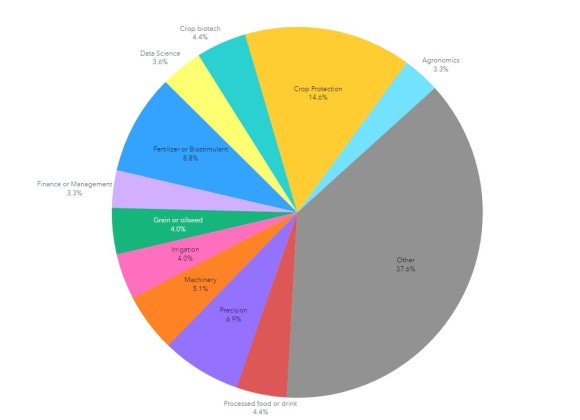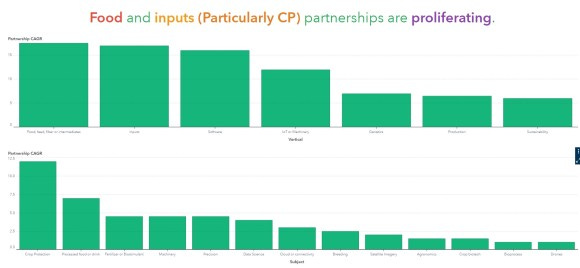A year ahead of food and fortune: The North America AgTech and FoodTech partnership landscape, trends, and data-driven 2022 predictions
Abstract
Through a comprehensive 4-year study of private sector North American partnerships, John Gottula shares insight into prominent innovation and growth areas for 2022. The information and hypotheses presented supports prudent business planning including portfolio and technology positioning.
Major findings
230 ± 79 AgTech and Foodtech partnerships will be announced in 2022 – appreciably more than past years. However, increasing price and revenue growth within the sector exert downward force on the trend.
The most (42 ± 14) partnerships will be in food, feed and fiber, an increase of a third from average of past 4 years. This is in part driven by inflationary pressures and consumer discretionary spending.
Software and crop inputs partnerships will enjoy good growth (to 25-50/year each), building on current momentum. Internet of Things (IoT)/machinery partnerships that go beyond interoperability will remain important and continue to grow (20-40/year).
At about 10-20 partnerships per year, activity related to agricultural production and sustainability will remain stable while genetics will slightly decline. The stasis of the sustainability landscape may relate to its insularity and the decline in genetics partnerships may represent a lasting effect of industry consolidation.
Number of partnerships and partner choice determines a company’s ecosystem centrality.
Stronger partnerships (denoted by the term ‘alliance’) are associated with terms connoting certain outcomes and straightforward goals.
Impetus and methods
AgTech and FoodTech experienced disruption in 2020 and 2021 through extensive venture investment on the heels of massive consolidation. Streams of private sector funding now more than make up for stagnating public sector investments (Burwood-Taylor, 2021; USDA-ERS, 2019). And the shakeup goes beyond funding: Through successful startup incubators and accelerator partnerships, startups are achieving synergistic growth opportunities (Hammerich, 2018; Kendall, 2021). Likewise innovation uptake within the blue-chip agriculture companies often comes through venture investment arms (e.g. Syngenta Ventures) or robust alliances programs (e.g. BASF Open Innovation Platform). Partnerships facilitate innovation and technology licensing, open new distribution networks, and support reciprocal commercial endeavors.
With partnerships increasing in popularity, the theme of the American Society of Agricultural and Biological Engineering NC Chapter 2021 annual meeting was “Partnerships.” It was in this venue I originally shared this study as its keynote speech.
The goal of the study was to determine the state of AgTech and FoodTech partnerships and gain insights through a rich analytics framework. I comprehensively mapped the network of interacting private sector AgTech and FoodTech communities and pinpointed opportunities for different industry actors to plug in. I identified areas of growing importance and unpacked potential causal factors. And I modeled how partnership-marketing press release language can be honed to optimize product positioning or recognize the strength of the relationships behind the announcements.
Scope
The AgTech and FoodTech partnership study was a systematic investigation of agricultural partnership media coverage. The criteria for study inclusion were:
The partnership was announced 2018-2021 between two private sector companies and was covered in at least one independent media outlet.
The announced or implicit partnership scope was to have significant presence or impact to North America and relevant on a regional, national, or international basis.
At least one partnering company must “touch” raw agricultural products and the partnership must advance an economic goal (i.e. not be limited to philanthropy or charity).
The basis of the partnership is not membership or subscription, and not limited to an API or interoperability.
To my knowledge this work is the most comprehensive study of private sector AgTech and FoodTech partnerships ever published.
Data engineering
The study was done between September and October 2021, covering a period of January 2018 to September 2021. Two hundred sixty-six web searches were logged with 352 partnerships matching the criteria were identified. The partnerships were categorized according to subject, agriculture sub-vertical, phase (e.g. commercial, innovation, distribution, etc.), and by connection name (partnership, collaboration, alliance, etc.). A summary of sub-verticals and subjects are summarized (Appendix 1).
Analytics
Data analytics were performed in SAS Viya® Visual Analytics. The results of network science, forecasting, natural language processing and machine learning algorithms are presented. Forecast model outputs were evaluated at 90% confidence intervals.
Trends
The frequency of partnership announcements is increasing AgTech partnerships grew at a 49% compound annual growth rate between 2018 and 2021. The largest and fastest growing partnership phase was commercial (43.8%) followed by innovation-type partnerships (31%). Service (e.g. IT support), finance or insurance, or distribution-type partnerships were less frequent (combined 25.3%) (Fig 2).
Partnerships showed a consistent quarterly uptrend without a discernable seasonal component. The major uptrend was broken in Q2 2020, followed by a quick rebound by Q3 2020 supporting strong and steady growth throughout the rest of 2020 into 2021 (Fig 3).
Except for a marked uptick in sustainability partnerships in 2020, partnership growth among sectors remained comparable throughout the period studied.
Partnership subjects
The most common partnerships identified were about 1) software, 2) crop inputs and 3) food, fiber and intermediates (Fig 4, Appendix 1). There were 62 software partnerships and 60 inputs partnerships. Software partnerships primarily cover precision enablement, data science, satellite imagery, or cloud/connectivity. Crop inputs include crop protection (including biological crop protection) and fertilizer/biostimulants. The third most common topic was food, fiber and intermediates, which encompasses processed food or drinks, meat substitutes and bioreactors/chemical intermediates.
Secondary partnership areas include crop biotech, grain or oilseeds, data science, finance or management, and agronomics. Highly diverse and individually less frequent ‘other’ subjects (Fig 5) round out the roster: breeding, crop insurance, drones, carbon, meat substitutes, renewables/emissions, crop warranty, feed, flavorings/additives, bioprocess, livestock, logistics/traceability, food access/utilization, packaging, seed, weather, fiber, indoor farming and a lone partnership supporting fresh produce.
Drivers of change
The fastest growing partnerships are the top 3 most common in reverse order: food-related partnerships (17.5% CAGR), inputs (17%) and software (16%) (Fig 6). Within these areas, there are notably high growth rates for crop protection (12%) and processed foods or drinks (7%). If these trends continue, we expect crop inputs and software development-related activity to remain prominent, while processed food and other FoodTech activity to surge.
To explore time series dynamics, AgTech and FoodTech partnership counts were fit to an autoregressive moving average (ARIMA) time series forecasting model. There was a significant time-series autocorrelation between monthly partnerships announced and crop producer price index (“Crop input prices” from the USDA National Agricultural Statistics Service) for the study period (Fig 7).
The forecast [based on an ARIMA(3,1,1) model] revealed three things about partnership trajectory for 2022:
The trend of more partnerships will continue into 2022
Higher producer price index is negatively correlated to partnerships. For every 1% decrease in producer prices, there are on average 5.6 more partnerships. I.E. lower prices or sector revenue, more partnerships.
The lag between a change in producer price index and partnerships is three months. I.E. lower prices or sector revenue, more partnerships next quarter.
2022 partnership expectations
High and continued rising input costs (American Farm Bureau, 2021) will exert downward pressure on the freight train increase of partnership activity. New partnership announcements are likely to grow at one marginal addition per month. In total, the forecast indicates there will be 230 partnerships (±79) in 2022. This compares favorably to 169 partnerships logged between January and September 2021 and expected to be well over double the 104 in 2020.
The model forecasts a rapid expansion (an increase of a third from the 2018-2021 average) of partnerships related to food (42 ± 14) (Fig 8).
Steady partnership growth will apply across most other sub-verticals. The only vertical where deceleration is more likely than not is genetics including biotech. The reduction in external private sector partnerships in genetics potentially reflects industry consolidation.
Sector landscape
Visualizing companies as nodes and partnership announcements as edges (connectors), a highly cohesive network emerges (Fig 9).
Twelve communities within the network were identified. These communities and their centroids are described in Table 1. Centroids are nodes with the highest “closeness centrality,” which is the condition of being innermost; community focus indicates the main partnership topics within those communities.
Read full content of the article at https://agtechfoodtech.com
About AgReads®
AgReads® is a website dedicated to the AgTech and FoodTech space. We provide news, opinions and analysis on AgriFood Tech companies from around the world.










